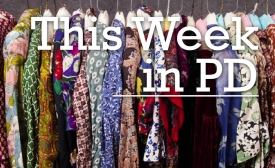fashion diplomacy
When Canada’s First Lady Sophie Gregoire-Trudeau was photographed alongside The Duchess of Cambridge this weekend, her outfit helped to accomplish the next stage in her carefully orchestrated ‘project’ to promote under-the-radar Canadian designers. [...] This strategy of wearing exclusively Canadian brands is one that Gregoire-Trudeau and her old-friend-turned-style-advisor Jessica Mulroney have been working on ever since they inadvertently created a fashion moment with the cream wrap coat Trudeau wore to see her husband sworn in as Prime Minister last year.
Silk today not only embodies the history of contact between the East-West, it is also a symbol of modernity and fashion. "Today, you'll find silk-made accessories and garments displayed in many high-end fashion stores in the US and Europe," Zhao said. "Which proves that silk is a welcome symbol in East-West cultural exchange."
Fashion designers blended influences from the Arabian Desert, the Middle Eastern lifestyle and European trends at a catwalk show in Amman on Thursday, marking the 25th anniversary of Ukrainian independence. [...] fashion week aimed to broaden Jordanians’ understanding of the Ukrainian people and strengthen the connection between the two countries.
“Can we make ‘made in Asia, designed in Asia’ become cool, I think yes we can because the stigma that Asian brands had is disappearing and we have all the right ingredients and the manufacturing base,” said Joowon Park, director at Seoul-based Simone Fashion Company.

Headlines explored the cultural highs and lows of fashion on the global stage.
Diplomacy is stitched into the royal wardrobe - detail is key. Embroidery, for example, has highlighted relationships between nations and regions. Her coronation dress boasted British and Commonwealth emblems. When the Queen visited Ireland in 2011, her robe for the state banquet at Dublin Castle was embellished with more than 2,000 hand-sewn shamrocks. Color is more than a shade. Its symbolism may govern options.
When Laurence Rossignol, France’s minister for women’s rights, likened women willingly wearing the burka to African-Americans backing slavery, she caused international controversy. […] She later apologized for the “language mistake” but she stands by her point, criticizing brands such as Marks and Spencer and H&M that are designing Islamic fashion.
In 2014, France’s ban on the burqa and niqab — versions of the veil worn by many Muslim women to cover their heads and their bodies — ignited a firestorm of criticism of how lawmakers continue to censor women’s bodies and how that very censorship simultaneously reflects and fuels increased fear in Europe.







